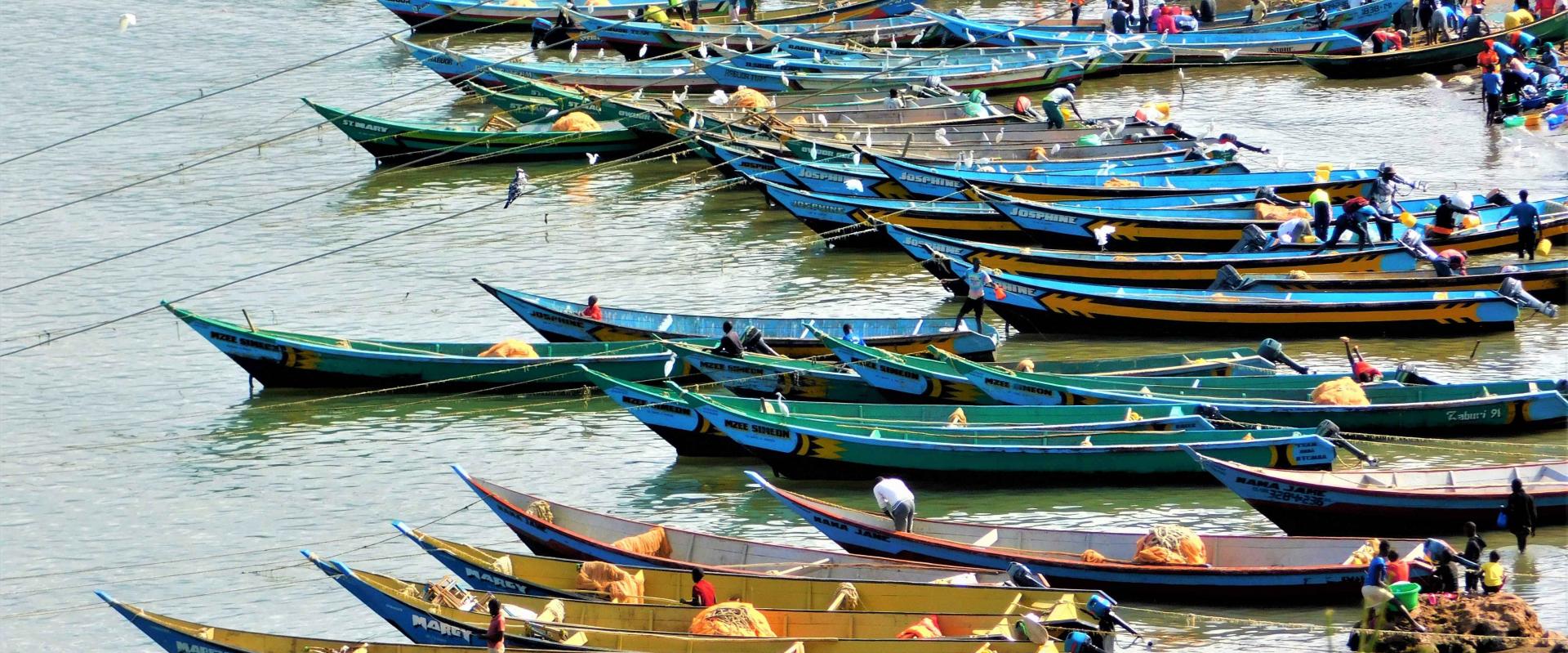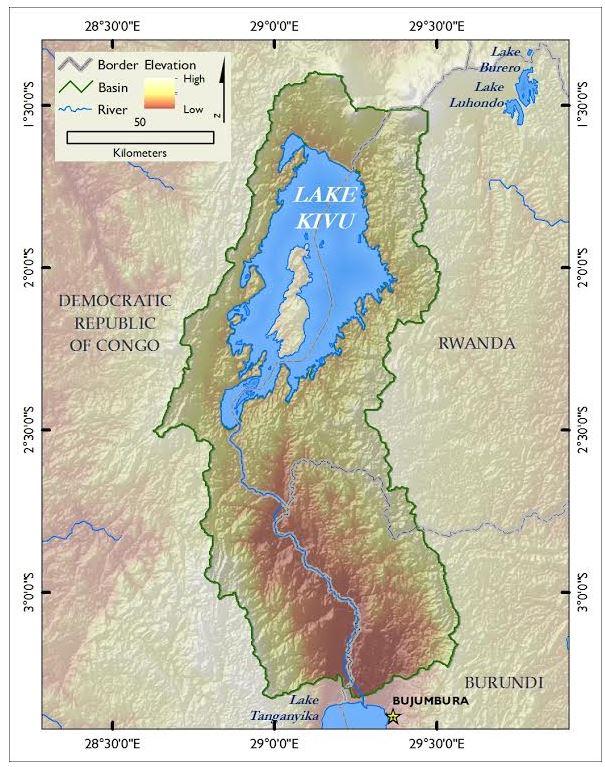
Lake Kivu Quick Links
Lake Kivu is one of the two smallest African Great Lakes, but is the third deepest and sits at the highest altitude.
Lake Kivu is located in an area with one of the highest population densities and population growth rates in the AGL region. Lake Kivu is home to around 28 fish species, half of which are cichlids found only in Lake Kivu. Lake Kivu is the largest local source of fish in Rwanda, providing more than 20,000 tons of fish per year and subsidizing fish imports for animal protein. The fishery supports 500,000 people in Rwanda and the DRC. Extraction of the large volumes of methane in Lake Kivu is expected to generate up to 25MW of electric energy but this extraction needs to be done in a safe manner as leaks could harm human health, biodiversity and the climate. There is a high potential for eco-tourism on the islands and around the lake. Rapidly increasing fishing pressure, deforestation, agricultural intensification and urbanization and climate change are the major threats to the lake.
Quick Facts
Bio-physical and demographic characteristics
- Shared by Rwanda and Democratic Republic of Congo (DRC)
- The only lake among the AGL with high amounts of methane and CO2
- Surface area = 2,370 km², shoreline = 860 km
- Basin has a population of ~2 million people
- One of the highest population densities and growth rates in the AGL region
- Majority of the population lacks clean water and has poor sanitation
Values and investment opportunities
- ~28 fish species, 50 percent of which are endemic cichlids with four introduced fish species
- Biggest local source of fish in Rwanda and produces ~21,400 tons of fish per year with the introduced Lake Tanganyika sardine as the main fishery
- Fishery supports ~500,000 people in Rwanda and the DRC
- Extraction of large volumes of methane could generate substantial electric energy
- High potential for tourism on islands and around the lake
Ecological and economic concerns
- Lake shores and basin are densely populated with settlements
- Localized eutrophication from land-use change along the lake shores
- Sardine fishery is threatened by rapidly increasing fishing pressure
- Deforestation, especially in Rwanda, is high due to the high population density
- Reported conflicts among fishers from Rwanda and the DRC
Governance
- Regional commission to coordinate policies and regulations for resource management
- National policies and regulations to guide development and conservation of natural resources are in place
- Some short-term regional projects have been implemented by international organizations
- Limited funding from national governments and international groups
Potential sustainable development interventions
- Improve the coordination of national management and promote community groups for development and conservation of natural resources
- Establish sustainable funding mechanisms for development and conservation of natural resources
- Enforce measures to ensure methane extraction is done sustainably and does not harm people and the environment
- Determine levels for a sustainable sardine fishery

Lake Kivu map.
Lake Kivu Advisory Group
Lake Advisory Groups are in the process of being developed. More information will be added as it is available.
Lake Kivu is one of the two smallest African Great Lakes (AGL), but is the third deepest and sits at the highest altitude. The lake was formed by volcanic activity about 1-5 million years ago. It has a surface area of 2,370 km2, a shoreline of 860 km, a length of 97 km and width of 48 km, an average depth of 240 m, a maximum depth of 485 m, water volume of 500 km3, a water residence period of 193 years, and a basin of 5,097 km2. Rwanda and Democratic Republic of Congo (DRC) both border the lake. Most of the water input is through rainfall (3.3 km3/year), numerous small rivers (2.0 km3/year), and ground water (1.3 km3/year), and water loss is through evaporation (3.6 km3/year) and the Ruzizi River into Lake Tanganyika (3.0 km3/year). The area receives long rainy periods from February to May and short rains from October to December, and the lake’s surface temperature varies between 22 and 24oC.
Lake Kivu is located in an area with one of the highest population densities and population growth rates in the AGL region. The lake basin has a population of about 2 million people. The population density around the lake is lower in the DRC side (89 people/km2), but is extremely high (350 people/km2) in Rwanda. The population growth rate is also higher in Rwanda (3.5% per year) than in DRC (2.5 %). The average per capita GNP was US$ 306 in DRC by 2014. The majority of the population lack clean water and have poor sanitation. Incidences of water-related illnesses such as cholera, is on the rise, especially on the DRC side and the HIV prevalence in Kivu region (Western province of Rwanda) is higher than national averages in both riparian countries.
Lake Kivu is home to around 28 fish species, half of which are cichlids found only in Lake Kivu. Four species have been introduced to the lake. Around 142 species of plants, 80 species of birds, 52 species of invertebrates, six species of mammals, six species of reptiles, and five species of amphibians are found in the lake and its basin. The area around the lake is made up of broad-leaved (semi) deciduous evergreen forests/woodland. Some species such as marsh mongoose (Atilax paludinosus), water birds, and snakes such as rhinoceros viper (Bitis nasicornis) and foresee cobra (Naja melanoleuca) are considered endangered and are listed on the IUCN red list.
Lake Kivu is the largest local source of fish in Rwanda, providing more than 20,000 tons of fish per year and subsidizing fish imports for animal protein. The introduced Lake Tanganyika sardine (Limnothrissa miodon) forms the main fishery. The fishery supports 500,000 people in Rwanda and the DRC. Extraction of the large volumes of methane in Lake Kivu is expected to generate up to 25MW of electric energy but this extraction needs to be done in a safe manner as leaks could harm human health, biodiversity and the climate. There is a high potential for eco-tourism on the islands and around the lake.
Rapidly increasing fishing pressure is threatening the Lake Kivu fisheries. Three tilapia species were introduced into the lake but did not establish well, likely because the shallow lake is not favorable for tilapias. Deforestation, especially on the Rwandan side, is high due to high population densities and needs to be controlled. The lake water is currently clear, but this is expected to change due to increased development along the lake shores. The shores and basin are densely populated, including Kabare, Goma, and Bukavu in DRC, and Gisenyi, Kibuye, and Cyangugu in Rwanda. The towns of Goma in DRC and Gisenyi in Rwanda are near the lake and the tourist hotels have been built on the shore. Future urbanization should be carefully planned with an intent to reduce impacts on the lake. The combined effect of agricultural intensification and urbanization in the densely populated western province of Rwanda is a potential source of pollution and eutrophication. Increase in temperature, decrease in wind speed, shifts in relative humidity and changes in lake levels over the past four decades are thought to have contributed to a decline in catches of the Lake Tanganyika sardine. Conflicts among fishers from Rwanda and DRC and political conflicts within DRC and Rwanda have affected the areas along the common borders of the two countries.
The Kivu and Ruzizi River Basin Authority could play an important role in coordination of policies and management of the shared resources of the lake. Other national research, management and community institutions for development and conservation of natural resources exist, but are not well coordinated. Policies and regulations to guide development and conservation of water, fisheries, wildlife, tourism, and agricultural resources do exist, and there have been proposals to ban fishing on the Rwandan side due to the rising number of fishers and the associated decline in catches. Pollutions is not yet a major problem, but is expected to increase with increased conversion to agriculture and urbanization in the basin and along the lake shores. Projects such as the Decentralization and Environmental Management Project (DEMP) address the dangers of ecosystem loss by protecting and restoring the lake shores and river banks. Some short-term international projects have occurred on the lake. National governments provide some funds for development and conservation of natural resources, but these funds are inadequate. The few regional projects are supported mainly by international organizations. International institutions have implemented short-term projects and most of their efforts have ended with the project.
A regional institution should be formed to coordinate policies and management of lake resources. The extraction of methane must be regulated such that it does not harm the people and the environment. Other interventions include establishing sustainable funding mechanisms for development and conservation of natural resources; addressing the rapid increase in basin population, especially on the Rwandan side, to reduce pressure on the environment and natural resources; determining suitable efforts for sustainable exploitation of the sardine fishery; controlling deforestation, especially on the Rwandan side of the lake; undertaking proper urban planning to reduce its impacts on the lake; and monitoring the impacts of cage fish farming.